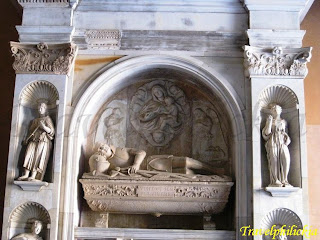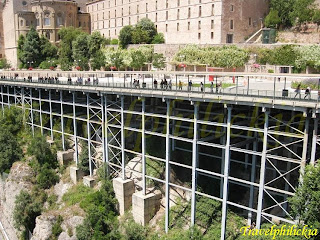Woke up in the morning for our day trip "Montserrat and Sitges Independent Day Trip from Barcelona". We booked this trip few weeks before our trip via the Viator Website that cost USD 89.71 per person.
Montserrat
After our simple breakfast, we then walked towards Catalonia Square and waited at the bus stop in front of El Corte Ingles departmental store. The tour bus (left photo below) arrived 15-mins earlier. After some simple verification by the tour guide, we then boarded the bus and the bus departed sharply at 8.30 am. Prior arrival, we were given some vouchers to the Montserrat (right photo below).

The multi-peaked mountain of Montserrat is unique in the world for its shape and form which are visible even from great distance. I was awed and impressed by its formation and quickly took several photos from the tour bus before reaching the funicular station (photos below).

The peaks of Montserrat are even more magnificent and imposing when looked from the foot of mountain (photos below). In Catalan, Montserrat literally means "Saw Mountain", and this best describes its peculiar feature with multiple rock formation. The mountain is composed of sedimentary rock – pink conglomerate. With its natural beauty, Montserrat becomes Spain's first National Park.


We alighted at Monistrol de Montserrat station (left photo below), and then we were given about 20-minutes of free time while our tour guide proceeded to get our railway tickets (right photo below). There is restaurant and washrooms available at the station for visitors to freshen-up before taking the rack railway.

The Montserrat Rack Railway (left photo below) is a railway that brings visitors from Monistrol de Montserrat station to the mountain-top monastery of Montserrat. The train has panoramic windows and is air-conditioned which provided a comfortable train experience (right photo below).

The train set off from the Monistrol de Montserrat and goes through a newly-constructed 160-meters La Foradada tunnel. After the tunnel, the train crosses the Pont del Centenari bridge, over the River Llobregat, and along right bank of River Tortuguer before reaching the second newly built Monistrol-Vila station. The steepest gradients of the route begin after leaving from second station, offering passengers spectacular mountain and valley views. Next the train continues upwards through the Tunnel of Àngel and Guilleumes Bridge where craggy outline of the mountain can be admired before reaching the last tunnel of the route, Tunnel of Apòstols. Past this station, the train makes further upward to the last station, Montserrat.
After alighted from the rack railway, we gathered outside the Montserrat station for a short tour briefing on Montserrat history by our tour guide. The Audiovisual building (left photo below) and Souvenir Shops (right photo below) are just in proximity of less than 100-meters from our gathering area.

We then proceeded to the Audiovisual Room Montserrat portes endins. In this exhibition, the life and organization of the Benedictine community of Montserrat will be revealed. One display that caught my attention was the model of Montserrat (photos below). It gives visitors the scale of Montserrat buildings against its surroundings.

Photographs and audiovisuals displayed in this exhibition showed the physical and historical context of Montserrat from its origin of the monastery and shrine to the present time (photos below).

After visiting the Audiovisual Room, we then walked towards the basilica through a long passageway (photos below).

Sculpture of Saint George (left photo below), similar to the bronze sculpture at Sagrada Familia, can be found at the atrium. Steep cliff of Montserrat can be viewed right from the atrium (right photo below). Sometimes with some imagination, these strange rock formations do resemble 'Rock Giants'.

Funicular tracks of more than 500-meters from the monastery to Sant Joan can be seen clearly from the atrium (left photo below).
Santa Maria de Montserrat is a Benedictine abbey at Monistrol de Montserrat (right photo below). This monastery is an important religious retreat in Catalonia. Due to the rugged outline of Mount Montserrat, the construction of the sanctuary is not uniform. It is made up of two main groups of buildings: the Basilica together with Monastery buildings, and the shops and houses for tourists and pilgrims.

The façade of Basilica is designed in neo-plateresque style between 1900 and 1901 (photos below). The sculptures of the 12 Apostles together with Jesus are the highlight of the building.

The central aisle of church measured 68.32-metres long, 21.5-meters wide and 33.33-meters tall. The whole building is covered with rounded Gothic arches which are supported firmly by walls which separated the six side chapels (photos below).

Venerated at the Santa Maria de Montserrat monastery, Virgin of Montserrat, also known as Black Virgin, is Catalonia's favorite saint. On September 11, 1881, virgin of Montserrat was declared to be the patroness of Catalonia. Since then the statue has been considered one of the most celebrated images in Spain. Photo left below is a replica of Virgin of Montserrat.
In the middle ages, pilgrims showed their devotion by hanging lamps in former Church of Montserrat. This tradition was later revived and still alive today (right photo below).

Visitors and Pilgrims can make some contributions to light up the candles (photos below).

Sgrafitti decorations can be seen on the walls of the porticoed section in the atrium (left photo below). Also an exquisitely decorated candle chandelier was spotted near the atrium (right photo below).

Fourteenth century tombs of Joan of Aragon (left photo below) and Bernat de Vilamari (right photo below) are located in the portal of the main front of monastery.

After much sightseeing, we decided to have lunch at La Cafeteria at Montserrat (left photo below). Ordered a plate of macaroons at EUR 5.50 with some fried vegetables at EUR 3.30 and large soft drink at EUR 2.35 (right photo below) for myself. Though pricey, its taste was acceptable and portion was fulfilling.

After lunch, we proceeded to admire the surroundings (photos below).


Interesting pictures can be taken using the arches at the atrium (photos below).

Impressive view of the monastery and the rock formation can be captured from the viewing platform (photos below).

While walking towards the car park for our tour bus, I was surprised that the flat ground on the road (left photo below) was actually supported by layers of steel piles (right photo below) over the steep mountains.

We then boarded the tour bus to continue our trip for Sitges.
Sitges
Sitges is a town about 35-km southwest from Barcelona. Located between the Garraf Mountains and the Mediterranean Sea, it is renowned worldwide for its Film Festival and Carnival, and has been described as "The Jewel in the Mediterranean Crown".
Our tour bus stopped along Parc de can Robert (left photo below) where huge sculpture of the letters 'SITGES' is located (right photo below).

Sitges has always been linked to the world of universal culture, and a place where moneyed classes spent the summer. The inheritances of the 'Americanos' who made their fortunes in the West Indies, built their beautiful mansions (photos below); making Sitges a town rich in architectural heritage and unique beauty.

The Maricel de Mar is one of Sitges' most recognizable buildings (left photo below). The building as it stands dates from 1911 was built on the foundation of an older chapel. It was rebuilt as a residence in a diverse Gothic style, but now serves as a museum housing a collection of mediaeval artwork. Maricel de Mar is linked to the Maricel de Terra building by a bridge (right photo below).

Just like most municipal museums, the Maricel de Mar museum (left photo below) has an impressive collection of ceramics and pottery, some good paintings and mediaeval sculptures. Our tour group didn't get to visit the museum, but rather walked pass it along Carrer d'en Bosch street (right photo below) towards the Church of Sant Bartomeu i Santa Tecla.

Easily the most identifiable landmark in Sitges, the Church of Sant Bartomeu i Santa Tecla (left photo below) juts out on a promontory overlooking the town. The church acts as the "lighthouse" in the old town where visitors can look out for its bell tower (right photo below), and can easily orient whilst wandering around in Sitges.

Crystal clear waters of the Mediterranean Sea are just in proximity to the town (photos below).

The promenade near the beach is neatly packed with apartments, and there are limited parking lots on a blind street making it rather quiet with few cars passing (photos below).

However the beaches are often packed with sun-bathers and rows of sunbeds and umbrellas (photos below).

We then walked around Sitges town to window-shop and at the same time looked for our souvenirs (photos below).

Boarded the tour bus and left Sitges at about 6 pm.
El Choquito Restaurant
Decided to have our dinner at El Choquito restaurant (left photo below) located along La Rambla. It is a Mediterranean-style restaurant (right photo below) with a good view of the famous La Boqueria Market. The restaurant offers fresh salads, meat, and a variety of cold and hot tapas.

According to my colleague, the tomato bread is a must-try Catalonia tapas. These are just grill bread spread with tomato, drizzle with oil and lastly sprinkle with salt; simple to make yet delicious tapas. We ordered what was recommended: some tomato bread (left photo below) and of course a plate of Fideuá (right photo below), again. For three consecutive nights we had been having Fideuá and never grew sick of it. Like all restaurants at La Rambla, the cost was pricey averaging to about EUR 22 per person.

Torre Agbar
Next sight after dinner: Torre Agbar. Took Metro L1 and alighted at Glòries station. We then walked for about 5-mins to the tower.
The 38-story skyscraper is the new landmark on the Barcelona skyline, added recently in 2003. The tower has an oval almost circular base and its interior is spacious without pillars. The outer panel wall is coated in different-colored glass blind which can be tilted at different angles. The color scheme changes from the warmer reddish tones at the base to cooler blues and whites at the top. At night it becomes a beautiful sight when the tower is lit up and saturated with colors (photos below).

Sagrada Família at night
Took Metro and alighted at Sagrada Família station to see the illuminated Sagrada Família. Only seeing for myself then I realized the building is impressive even at night (photos below). This trip gives us an idea what to expect the next day when we visit Sagrada Família in the morning.
 Posts RSS
Posts RSS








































